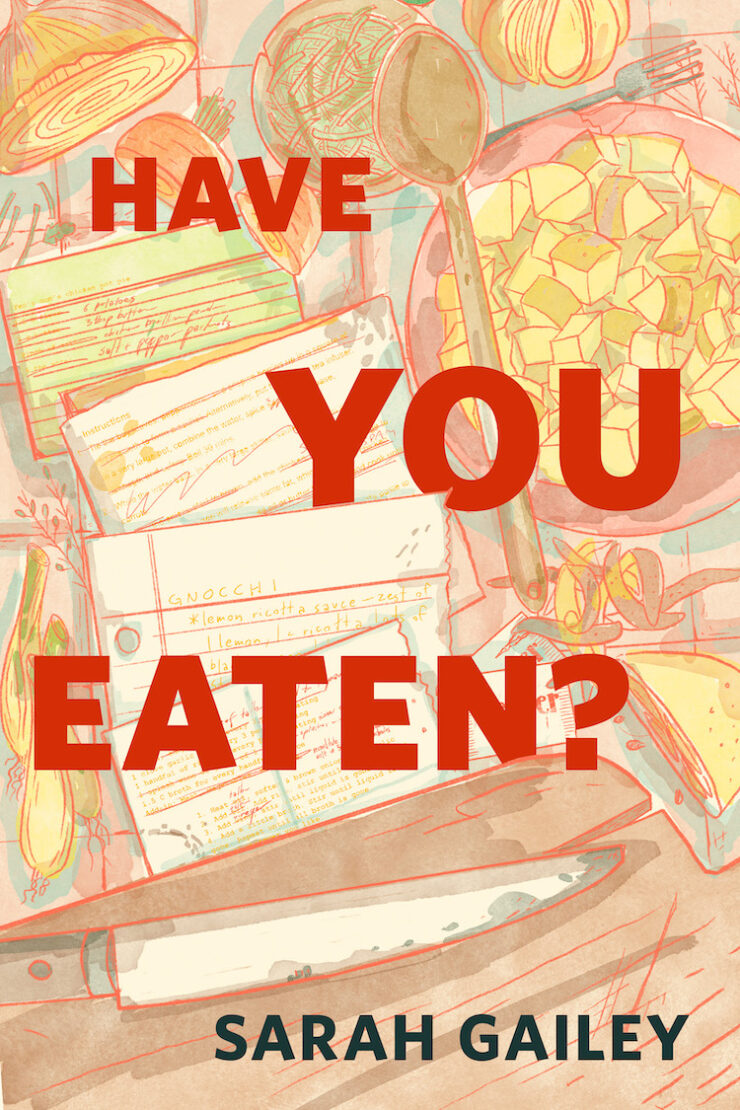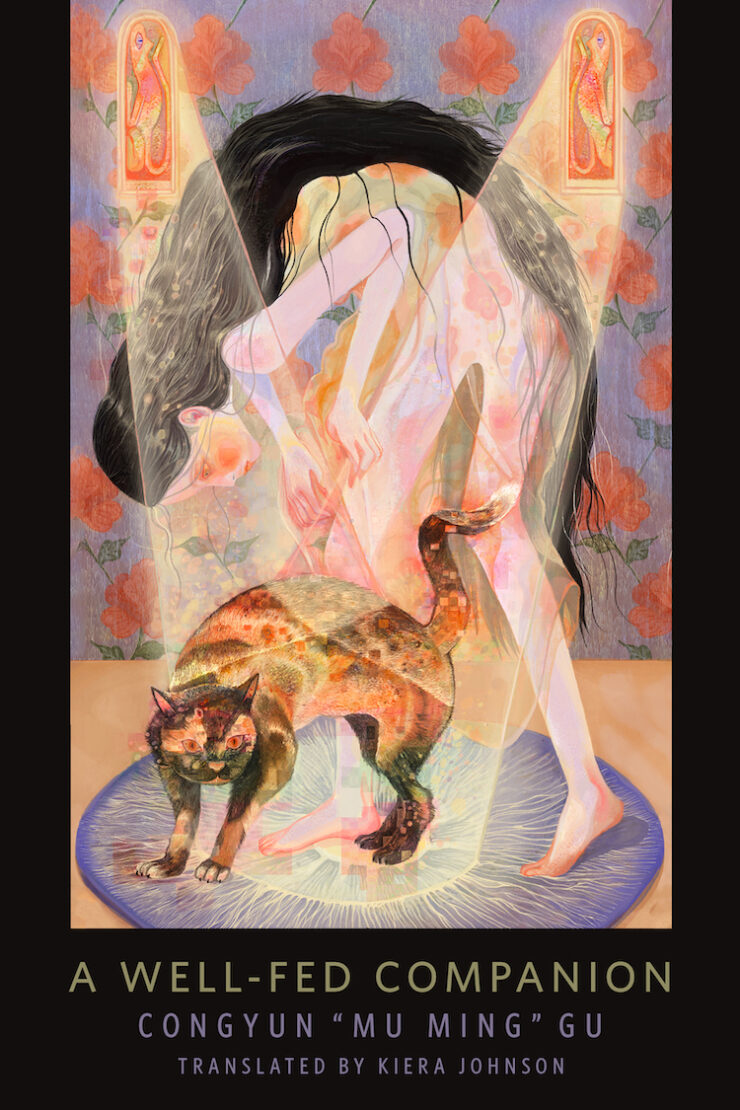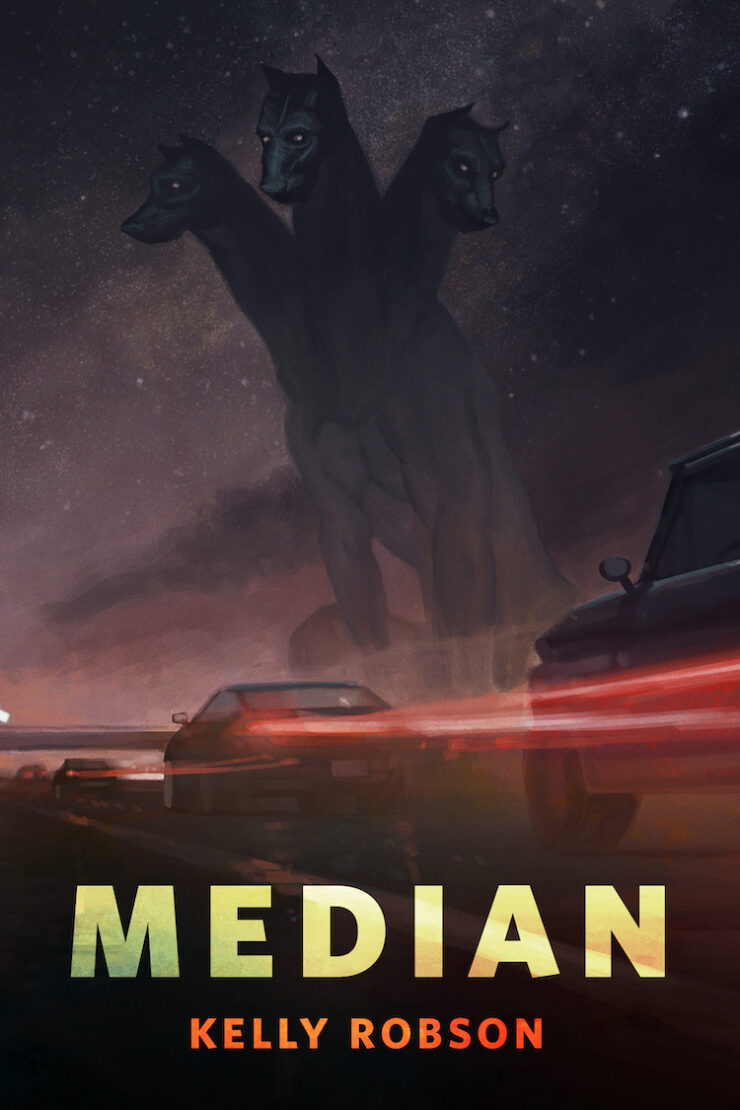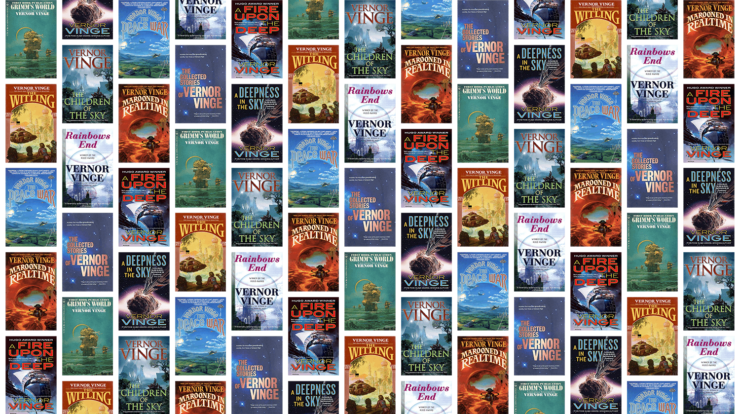Vernor Vinge, acclaimed author of hard science fiction, died on March 20, 2024. Vinge’s career stretched from the early 1960s to the early 21st century. His mantlepiece accumulated a healthy assortment of trophies over the years, from the Hugo to the Prometheus to the Campbell Memorial1. That said, no author is so famous that everyone knows of them or has read their work. Some of you may have discovered that Vinge existed at all by reading about his passing. Such folk may wonder where to begin with Vinge’s work.
While Vinge had a long career, he was never a prolific writer. Indeed, reading all of his fiction is quite doable. If you’re up for that (or if you’d rather just pick and choose where to dive in), here’s a list of his novels and collections2, with brief comments.
Grimm’s World (1969)
Grimm’s World details the adventures of one Tatja Grimm, a brilliant young woman determined to earn a destiny far greater than any calling her backwater homeworld could offer. Her prodigious abilities make her a valuable asset to potential employers. However, each employer and ally are but stepping stones on the Übermensch’s journey.
Grimm’s World seems consciously crafted to appeal to editor John W. Campbell, Jr.; the plot features a science fiction magazine. Thus I was somewhat surprised to find that Grimm’s World began as a story not in Analog but in Damon Knight’s Orbit 43. Perhaps dissatisfied with the original novel, Vinge later revised and greatly expanded the work into 1987’s Tatja Grimm’s World.
The Witling (1976)
No sooner do the Novamerican scouts land on Giri than most of the crew dies in a mishap, leaving Yoninne Leg-Wot and Bjault marooned on a planet whose biochemistry will soon kill them. Fortuitously, not only is Giri inhabited, and not only do the locals have an extraordinary gift (teleportation), but alien Prince Pelio considers Leg-Wot an exotic beauty. Too bad about that Giri’s cutthroat dynastic politics. Too bad that the plan to return to Novamerica may require betraying Pelio, of whom Leg-Wot is quite fond.
Unfortunately, every author has their worst book. This is Vinge’s. Vinge had considerable fun playing with the implications of psionic teleportation. Other elements disappoint, in particular the fact that Leg-Wat’s happy ending involves a lobotomy.
The Peace War (1984)
Next up, Vinge’s Realtime duology.
In a heartbeat, astronaut Allison Parker was transported from Cold War America to the quasi-feudal world of the so-called Peace Authority. Peace Authority founders wielded the “bobble,” a spherical forcefield, to shatter civilization, kill billions, and smother progress all in the name of global peace. That doing so empowered and enriched the Peace Authority was surely a happy side effect. However, not having invented bobbles, the Peace Authority fundamentally misunderstands their nature. They have also woefully underestimated humanity’s determination to be free.
The Peace Authority’s big mistake (well, second biggest, after being an authoritarian cabal in a novel with libertarian themes) was failing to understand that time stops inside bobbles. As with the teleportation in The Witling, Vinge has considerable fun playing with the implications of spherical stasis fields.
Marooned in Realtime (1986)
Bobbles offer escape from immediate calamity at the cost of being displaced into an uncertain future. The protagonists of Marooned in Realtime emerged from their individual bobbles to find themselves alone in a world without humans. The impressive technology of tomorrow offers hope of survival, but it will not protect the castaways from the killer in their midst.
Marooned is a number of things: a fast-forward tour of Earth’s development over millions of years and a murder mystery are but two of them. It is also an example of the thinking that shaped Vinge’s career: having convinced himself of the nigh-inevitability of the technological Singularity, Vinge then had to figure out how to create characters and events that would not be too alien for modern day readers.
A Fire Upon the Deep (1992)
All of which brings us to Vinge’s magnum opus, the Zones of Thought trilogy. The Zones of Thought, first showcased in his then-wife Joan D. Vinge’s The Outcasts of Heaven’s Belt, were Vinge’s other solution to the Singularity. Computational prowess depends on location within the galaxy. Earth (which is far off-stage) cannot experience singularity because local laws of physics preclude superhuman intelligence. Migration to other regions facilitates more advanced technology…at a risk.
Bold archaeologists locate and open an archive on the edge of the Transcend. The archive contains a Blight. This is a terrible mistake, and the last one the explorers make. The sealed evil in a tin wastes no time infecting and enslaving every being within reach. However, the Blight is as overconfident as it is ravenous. A lone spacecraft bearing a handful of survivors, mostly children, flees from the Blight, bearing with them a countermeasure as old as the Blight itself. Will the Blight’s enemies be willing to pay the price that the Countermeasure demands?
While the Singularity appears to have been at the back of the author’s mind when plotting the novel, in Fire Vinge keeps the focus on the struggle against the Blight and the adventures which his plucky freedom fighters must survive in order to save the galaxy4.
Fire is the novel where all of the elements of Vinge’s writing fully came together. If it’s not the novel Vinge fans count as their favorite, then their favorite is almost certainly…
A Deepness in the Sky (1999)
Set 20,000 years before Fire, Deepness details the efforts of a sublight human starship manned by Qeng Ho traders to contact a most curious alien race, for the material betterment of both sides. Unfortunately for the humans aboard the ship and the alien Spiders, the authoritarian Emergents also have designs on both the ship and the Spiders—those designs being subjugation and slavery.
Some readers may be fascinated by Vinge’s efforts to imagine what thousands of years of singularity-free civilization might look like. Bad news: it’s an endless boom/bust cycle, spiced with inescapable relics of ancient technological decisions. Others may simply enjoy a tale of struggle between the self-congratulatory evil of the Emergents and their hapless victims. Me, I am here for the Bussard ramjets.
The Children of the Sky (2011)
The third and final book in the trilogy, Children is set ten years after Fire. Remnants of the Blight have survived Countermeasure, and may someday target the backwater world on which Ravna and the other survivors are currently marooned. Ravna sets out to provide the Tines, the local aliens, with the means to fend off the Blight’s remnants…but not only are some of the Tines uninterested in cooperating with Ravna, they have convinced themselves that the Blight was the hero of the recent conflict.
I greatly resent how recent events make it impossible for me to complain that nobody could possibly think the brain-eating monster from beyond the stars was their friend. Still, it is best to focus on the positive: authors now have so much more leeway for characters to plausibly embrace willfully self-destructive courses of action.
Rainbows End (2006)
Rapidly advancing medicine cures Robert Gu’s Alzheimer’s disease. Gu must learn to adapt to the rapidly changing world he expected to soon exit. Also, the grave will no longer protect him from the consequences of his abominable treatment of friends and family. Are rehabilitation and reconciliation possible, or are some mistakes unfixable?
Rainbows End is set right on the cusp of the Singularity, when things are getting weird but are not yet incomprehensible to Mark I human brains. Many readers will most clearly remember the thriller plot that manifests partway through the narrative. Me, I am haunted by the legitimately horrifying approach to archives featured in the novel.
The Collected Stories of Vernor Vinge (2001)
Finally, the short fiction. Like many authors of his vintage, Vinge began as a short fiction author, first appearing in New Worlds5.
The Collected Stories is (save for one omission) the go-to collection for which the Vinge-curious should search. The contents span Vinge’s career from its beginning to the publication of the collection, allowing readers to enjoy Vinge’s development as an author.
However, my single caveat regarding this collection is a huge one: Vinge’s most famous short story is arguably the Hugo and Nebula-finalist “True Names,” which is nowhere to be seen. For that, readers will have to track down the anthology True Names and the Opening of the Cyberspace Frontier (2001) or the collection True Names… and Other Dangers (1987)6.
Are there upcoming Vinge projects of which I am unaware? Are there individual works that Vinge fans wish to discuss at greater length? If so, comments are below.
- Not the award that is now known as the Astounding, but a different award that is also not a Hugo Award. ↩︎
- I am omitting chapbooks, Binary Stars, and anthologies. ↩︎
- The same Orbit series whose New Wave tendencies so inflamed the outrage of the Science Fiction Writers of America grognards. Despite appearing in Orbit, Vinge was not a New Wave SF author. ↩︎
- Another player in Fire is a galactic communications network oddly similar to Usenet. We now know that if a galactic communications network existed, it would resemble
MySpace LiveJournal TwitterTik Tok. ↩︎ - New Worlds was known for publishing New Wave SF. Nevertheless, Vinge was in most respects the antithesis of a New Wave SF author. ↩︎
- You might want to keep an eye out for the Vinge collection Threats… and Other Promises (1988)as well. ↩︎










